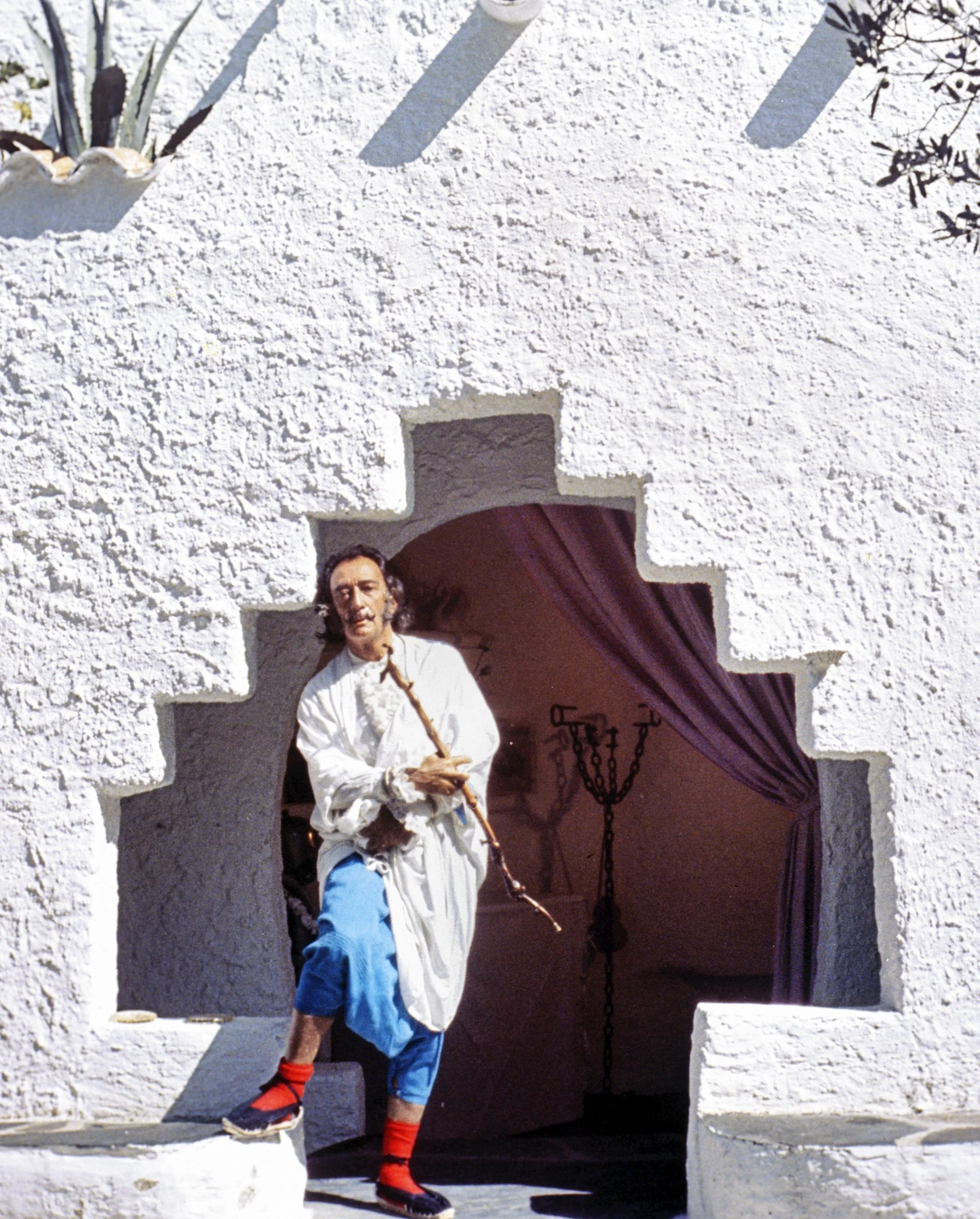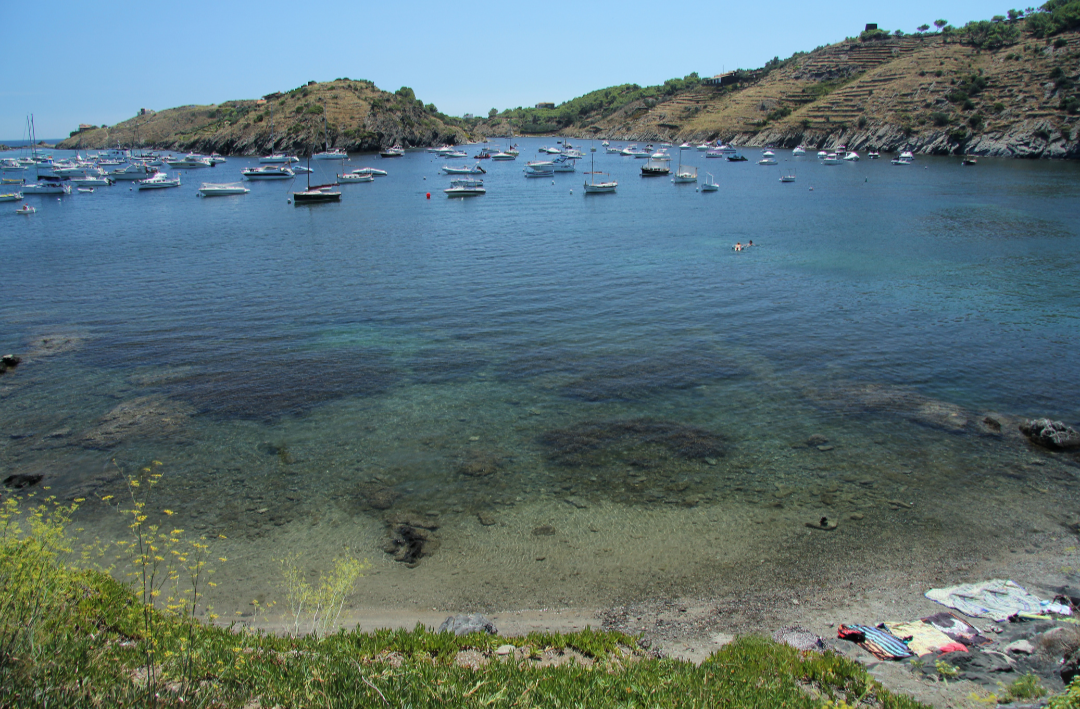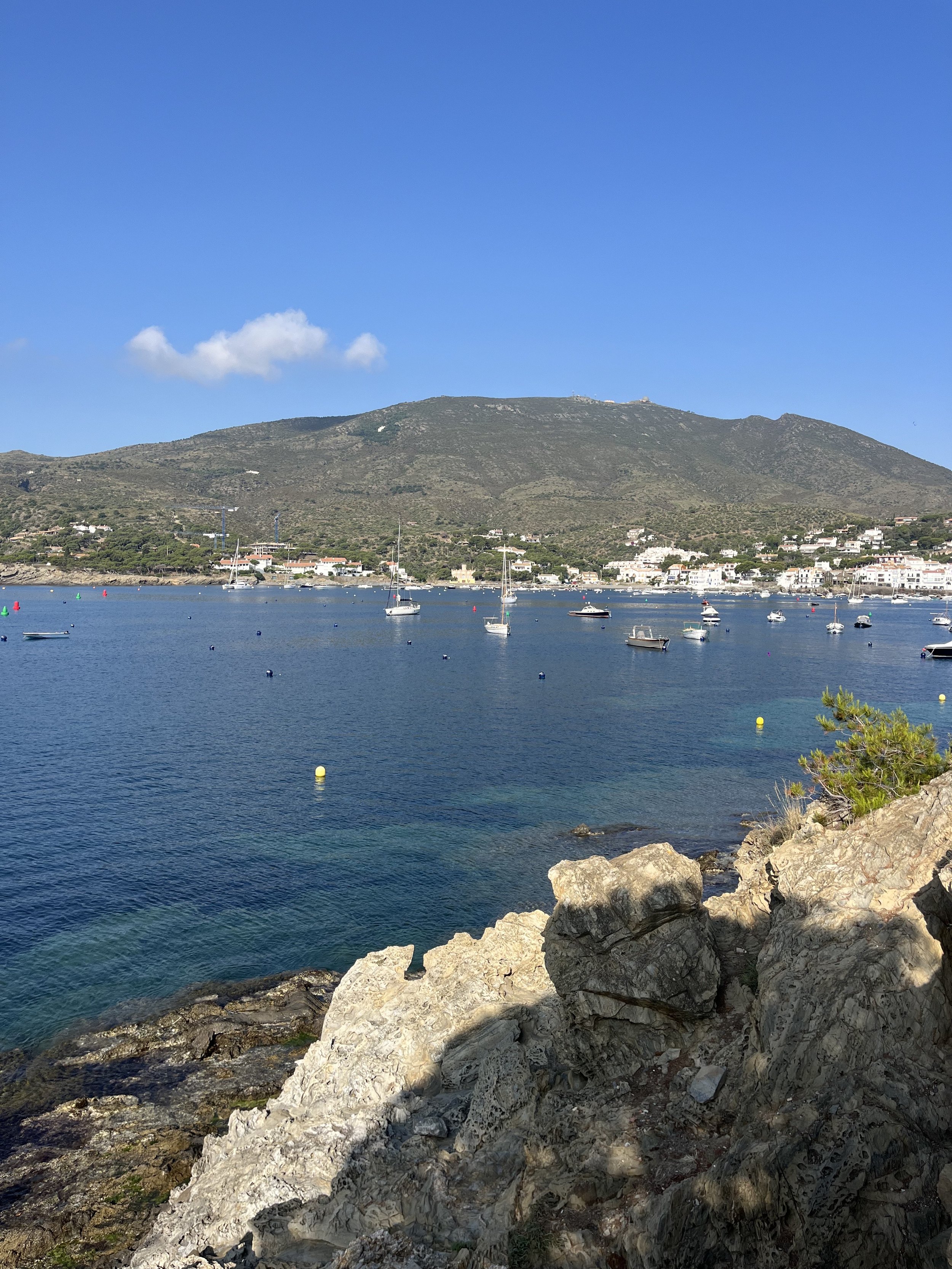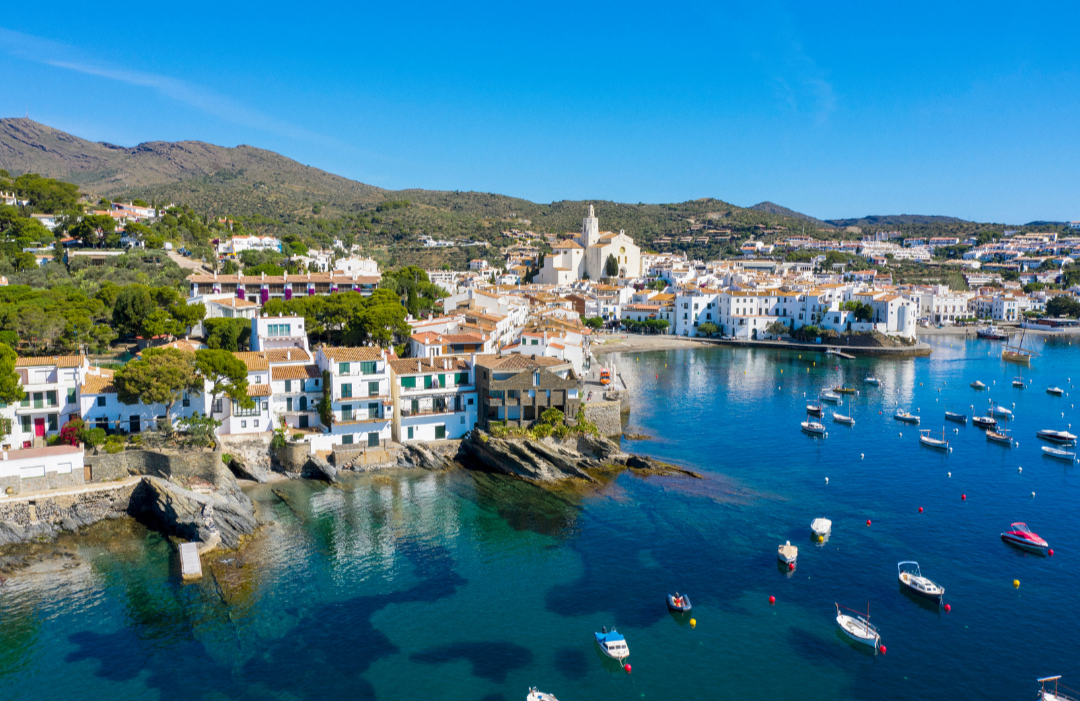
Casa Verda : Luxury villa in Cadaqués > Cadaqués Travel Guide > Salvador Dalí in Cadaqués
Salvador Dalí in Cadaqués:
From the Museum to the Village
Step into the surreal world of Salvador Dalí in Cadaqués, the coastal village that shaped his imagination. From his house-museum in Portlligat to the winding streets he once walked, follow the traces of the artist’s life and discover how this Mediterranean haven inspired some of his most iconic work.
Dalí and Cadaqués: A Lifelong Connection
Born in 1904 in Figueres, Salvador Dalí was introduced to Cadaqués at an early age. His family owned a summer house in the village and they would travel to this remote corner of the Costa Brava every summer to escape the intense heat of inland Catalonia. For the young Dalí, Cadaqués became a place of wonder and discovery. The contrast between the quiet village life and the wild, untamed coastline sparked his imagination. Surrounded by rocky coves, bright Mediterranean light and the ever-changing sea, Dalí began to sketch and paint. His father, a strict notary, encouraged discipline, while his mother nurtured his creativity. These formative summers were crucial in shaping Dalí’s artistic sensitivity and deep connection to the surreal beauty of nature, elements that would become central to his later work. Cadaqués wasn't just a holiday destination; it was the place where the seeds of his artistic identity were first planted.
As Dalí matured and entered the avant-garde art world, he never lost his emotional ties to Cadaqués. In the late 1930s, after meeting his lifelong muse and partner, Gala Éluard, the couple returned to the region and chose to settle in nearby Portlligat, a quiet cove just outside the village. Drawn by its isolation and raw landscape, Dalí purchased a small fisherman’s hut and, over time, expanded it into a labyrinthine house. Together with Gala, he designed the space as both a home and a living work of art. Every room was intentionally crafted, filled with eccentric objects, mirrors and symbolic details. The house reflected Dalí’s inner world, a surreal, dreamlike space that blurred the line between life and creation. While the outside world often saw Dalí as flamboyant and theatrical, Portlligat offered him a private sanctuary. It was here, surrounded by nature and solitude, that he found the focus to paint some of his most iconic masterpieces. The choice to root his life in this quiet coastal cove speaks volumes about his need for retreat, reflection, and ritual.
Portlligat was far more than an address for Dalí, it was the epicenter of his artistic existence. Unlike other artists who moved from city to city, Dalí remained remarkably loyal to this small bay. From the 1940s until Gala’s death in 1982, he lived and worked in the house-studio full time. The surrounding landscape, the twisted olive trees, the stony hills of Cap de Creus and the calm waters of the bay, became visual motifs in countless paintings. Works such as The Persistence of Memory and The Disintegration of the Persistence of Memory echo the dreamlike atmosphere of this setting. But beyond inspiration, Portlligat gave Dalí something he cherished deeply: structure. He followed strict routines, rising early to paint in the soft morning light, receiving guests in the afternoons and devoting hours to reflection and planning. The house, now a museum, offers a glimpse into this world: eccentric yet methodical, deeply personal yet full of theatricality. In Portlligat, Dalí built not only a home, but a timeless universe, part retreat - part performance, entirely his own.
Why did Salvador Dalí Love Cadaqués?
Dalí didn’t just admire Cadaqués, he needed it. It was his emotional anchor, the place he returned to throughout his life, during moments of joy, doubt and creative transformation. The calm of this isolated village offered him the solitude he craved, far from the noise of the world and the art scene.
In Cadaqués, he found not only inspiring landscapes, but a rhythm of life that shaped his artistic identity, the light, the silence, the daily habits of locals all became part of his creative process. It was here that he lived many of his most beautiful and formative moments.
Cadaqués was not just a backdrop to his art, it was the reflection of his inner world.
Visiting the Dalí House Museum in Portlligat
What Will You See inside the Dalí Museum?
Inside the Dalí House Museum in Portlligat, visitors can explore the artist’s former home and studio, preserved as a fascinating museum showcasing his artworks, personal belongings, and unique surrealist décor. Highlights include the iconic Bear Hall with its stuffed bear, Dalí’s studio with original painting tools and stunning views of the Mediterranean coastline, and the intimate private rooms filled with personal artifacts reflecting his and Gala’s life. The guided tours also lead you through the whimsical courtyard featuring sculptures and the famous pool area. This visitor experience offers a rare glimpse into Dalí’s creative world and the inspiration behind many of his masterpieces.
How to Visit the Dalí House Museum ?
To visit the Dalí House Museum in Portlligat, it’s essential to book your tickets in advance, as access is limited and reservations are mandatory. The museum allows only a small group of visitors at a time (typically up to 8 visitors), ensuring a quiet, immersive experience. You can choose between a self-guided tour or a guided visit for deeper insights into Dalí’s life and creative space. Entry times are strictly scheduled, so arriving early is recommended. For up-to-date details on opening hours, prices and how to plan your trip, visit the official museum website before your visit.
Dalí & Cadaqués: Places That Echo His Legacy
Portlligat Bay
Nestled in a calm Mediterranean inlet, Portlligat Bay is where Salvador Dalí established his iconic surrealist residence. This tranquil spot, lined with fishing boats, was both his sanctuary and a source of inspiration. One of the most memorable vessels was the Gala, Dalí’s personal boat, named after his muse and partner. He often sailed it along the jagged Costa Brava shoreline, sketching and observing the changing light and forms. Today, the bay is a centerpiece of many cultural walking tours and serves as a launch point for guided boat excursions focused on Dalí’s legacy.
Santa Maria Viewpoint
Standing above the sun-bleached stone buildings of Cadaqués, the Santa Maria Church viewpoint offers one of the most striking view in the region. From here, you can see the entire bay framed by the rolling hills of Cap de Creus and the sparkling Mediterranean beyond. Dalí often depicted this panorama in his works, capturing the harmony between nature and village life. Today, the viewpoint is a favorite on walking tours, especially for photography enthusiasts and visitors seeking an authentic glimpse of Dalí’s daily surroundings.
Cap de Creus
With its windswept cliffs and fantastical rock formations, Cap de Creus feels like stepping into one of Dalí’s canvases. This dramatic coastal landscape, just beyond Cadaqués, fascinated the artist with its naturally sculpted shapes and shifting shadows. He saw in its geological features the essence of surrealist imagery, often incorporating their outlines into his paintings. Visitors can explore the park via self-guided hikes or join a guided tour to experience firsthand the views that sparked Dalí’s imagination.
Contemporary Art Galleries
Cadaqués continues to thrive as an artistic destination, in part thanks to Dalí’s enduring influence. Scattered throughout the town, contemporary art galleries showcase bold works by modern Catalan creators, international avant-garde artists, and local talents. These vibrant spaces offer rotating exhibitions, artist meet-and-greets, and sometimes docent-led visits, making them ideal stops on self-guided cultural itineraries. Walking through these galleries is a way to connect with the innovative spirit that Dalí helped to ignite in the region.
Extend the Magic of Cadaqués with a Stay at Casa Verda
After following in Dalí’s footsteps, stay at Casa Verda, a peaceful villa in the heart of the village he once called home. Ideally located near Portlligat, it’s a place where art, nature, and comfort come together.
Discover more about Cadaqués
There’s more to Cadaqués than its artistic legacy. From scenic beaches and buzzing bars to local restaurants and unforgettable experiences, we’ll help you enjoy the town’s many sides, whether you’re here to unwind, explore or simply take it all in.
Cadaqués & Dalí: Frequently Asked Questions
-
Salvador Dalí’s house is located in Portlligat, a small picturesque cove just a short stroll from the center of Cadaqués, on the Costa Brava. Nestled in a former fisherman’s hut, this seaside residence became the artist’s primary home and studio for decades. Today, it’s a museum that offers a unique guided tour through Dalí’s surreal universe, with views overlooking the stunning Mediterranean landscape that inspired much of his work.
-
Absolutely. Visiting the Casa-Museu Salvador Dalí in Portlligat is one of the top things to do in Cadaqués for any art lover, history enthusiast or cultural traveler. The house is not only a beautifully preserved modernist structure, but also an immersive look into the mind of the surrealist master. You'll see original artworks, personal items and eccentric architectural elements that reflect Dalí’s personality.
-
Yes, reservations are required. The Salvador Dalí house-museum has a limited daily capacity and visits are only allowed in small groups or with a tour guide at pre-set times. Especially during peak season or weekends, tickets often sell out days in advance. To secure your visit, it’s recommended to book your tour online well ahead of your trip.
-
Portlligat holds a deep personal connection to Salvador Dalí, it was his home, his sanctuary and his artistic laboratory. Though technically a small bay near Cadaqués, Portlligat is now globally recognized due to the presence of Dalí’s house-museum. The tranquil coastal scenery, rocky peninsula and play of light in the area deeply influenced Dalí’s landscapes and surreal imagery. The village of Cadaqués itself, once frequented by artists and poets, was a vital part of Dalí’s creative circle.
-
Yes, Dalí was a familiar face in Cadaqués, especially during the summer months. He often wandered through the old town, visited local cafés and entertained guests on the seaside promenade. One spot of interest is the Church of Santa Maria, whose white façade and elevated location appear in some of his paintings. Exploring Cadaqués on a self-guided tour or a guided walking tour lets visitors uncover places that were part of Dalí’s everyday life.
-
Definitely. The walk from Cadaqués to the Dalí house-museum in Portlligat takes about 10-15 minutes. It’s a leisurely stroll along a scenic route with beautiful views of the coastline and traditional Catalan houses. Many visitors choose to include it in their self-guided itinerary or join guided walking tours that explore the artistic heritage of the area. Comfortable shoes are recommended due to the uneven, cobbled paths.
-
The ideal time to visit is during the spring or early autumn, when the weather is pleasant and the crowds are smaller. Summer is also beautiful, but it’s peak tourist season, and you’ll need to book your visit well in advance. Early morning time slots offer the most relaxed experience and the best natural light for photos.
-
Yes, but with some considerations. The museum welcomes families, school groups and tour groups but due to the narrow passages and the intimate nature of the house, group sizes are limited. Children often enjoy the whimsical and surreal elements of the space, like the giant stuffed bear, the egg-covered roof and eccentric sculptures, but younger visitors might need supervision due to the fragile exhibits. Many guided tours cater to families, offering explanations adapted for younger audiences.















